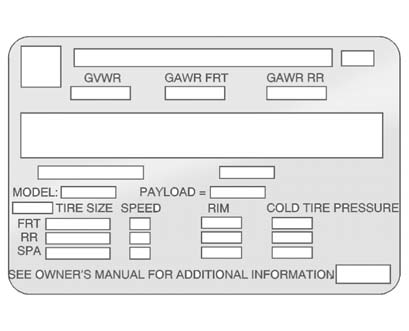Certification Label
 " width=409 height=331
id="_x0000_i1628" src="images/books/1183/6/index.43.gif" border=0>
" width=409 height=331
id="_x0000_i1628" src="images/books/1183/6/index.43.gif" border=0>
Label Example
A vehicle-specific Certification/ Tire label is attached to the driver side center pillar (B-pillar).
The label shows the size of the vehicle's original tires and the inflation pressures needed to obtain the gross weight capacity of the vehicle. This is called Gross Vehicle Weight Rating (GVWR). The GVWR includes the weight of the vehicle, all occupants, fuel, and cargo.
The Certification/Tire label also tells you the maximum weights for the front and rear axles, called Gross Axle Weight Rating (GAWR). To find out the actual loads on the front and rear axles, you need to go to a weigh station and weigh the vehicle.
Your dealer can help you with this. Be sure to spread out the load equally on both sides of the center line.
Never exceed the GVWR for the vehicle, or the GAWR for either the front or rear axle.
If the vehicle is carrying a heavy load, it should be spread out.
See УSteps for Determining Correct Load LimitФ earlier in this section.
WARNING
Do not load the vehicle any heavier than the Gross Vehicle Weight Rating
(GVWR), or either the maximum front or rear Gross Axle Weight Rating (GAWR).
This can cause systems to break and change the way the vehicle handles. This
could cause loss of control and a crash. Overloading can also shorten the life
of the vehicle.
Your warranty does not cover parts or components that fail because of overloading.
The label will help you decide how much cargo and installed equipment your vehicle can carry.
Using heavier suspension components to get added durability might not change your weight ratings. Ask your dealer to help you load your vehicle the right way.
If you put things inside your vehicle Ц like suitcases, tools, packages, or anything else Ц they will go as fast as the vehicle goes. If you have to stop or turn quickly, or if there is a crash, they will keep going.
WARNING
Things inside the vehicle can strike and injure people in a sudden stop or
turn, or in a crash.
- Put things in the cargo area of the vehicle. In the cargo area, put them as
far forward as possible.
Try to spread the weight evenly.
- Never stack heavier things, like suitcases, inside the vehicle so that some
of them are above the tops of the seats.
- Do not leave an unsecured child restraint in the vehicle.
- Secure loose items in the vehicle.
- Do not leave a seat folded down unless needed
See also:
Horn
Pressaon the steering wheel pad
to sound the horn. ...
BATTERY SAVER ACTIVE
This message displays when the
system detects that the battery
voltage is dropping below expected
levels. The battery saver system
starts reducing certain features of
the vehicle that may be ...
Inst (Instantaneous) Economy
Displays the current fuel economy
in either liters per 100 kilometers
(L/100 km) or miles per gallon
(mpg). This number changes
frequently as driving conditions
change. It cannot be reset. ...






